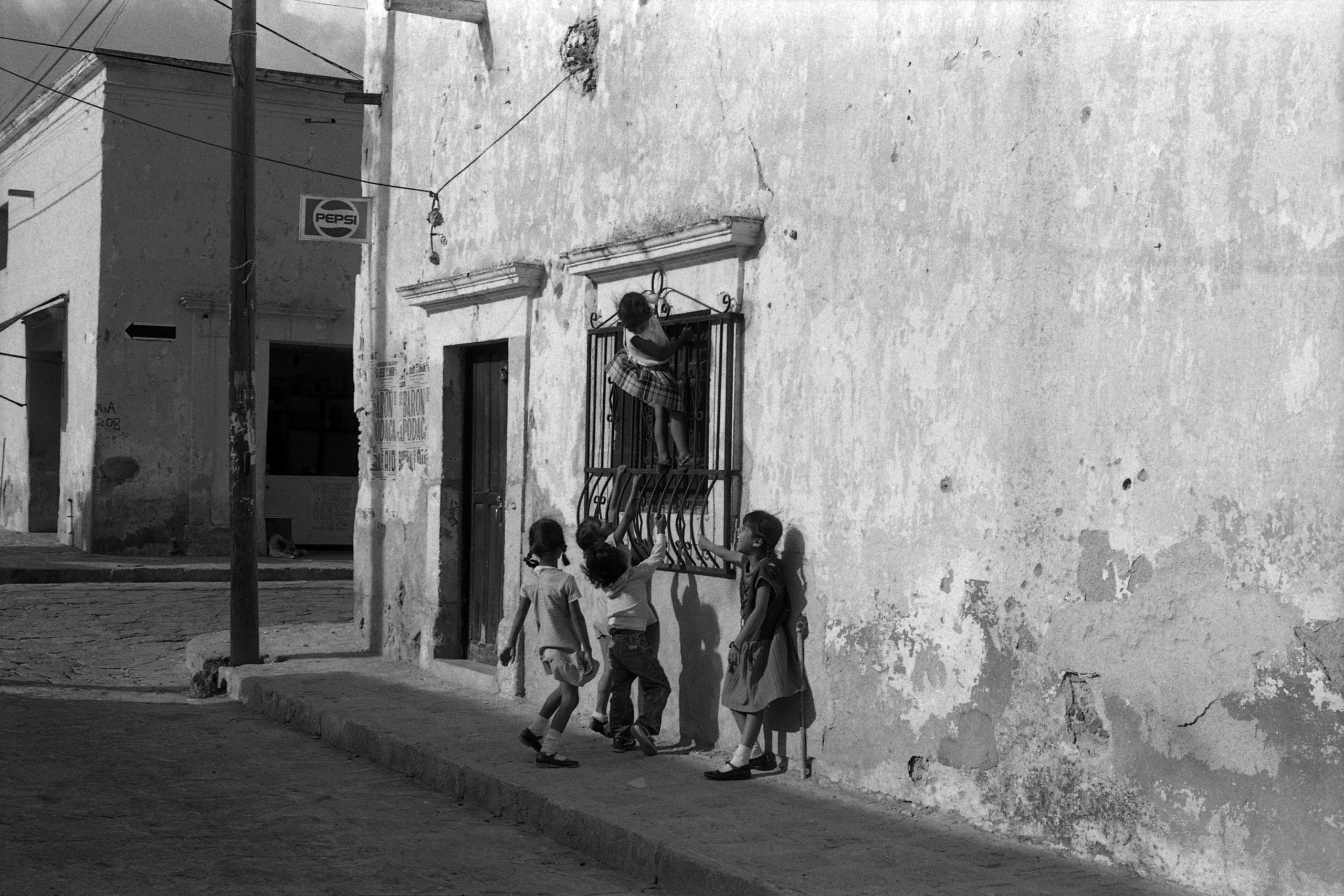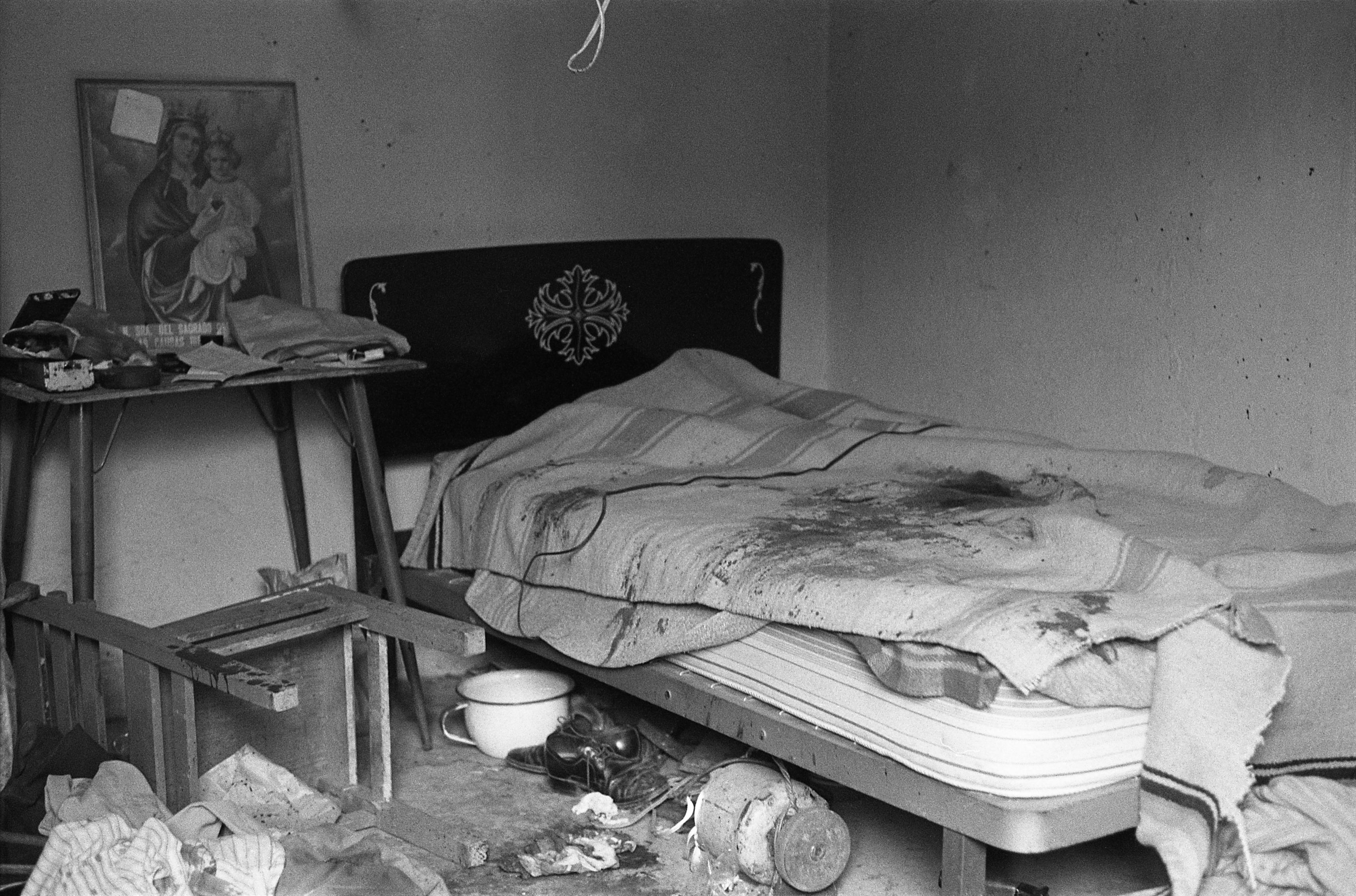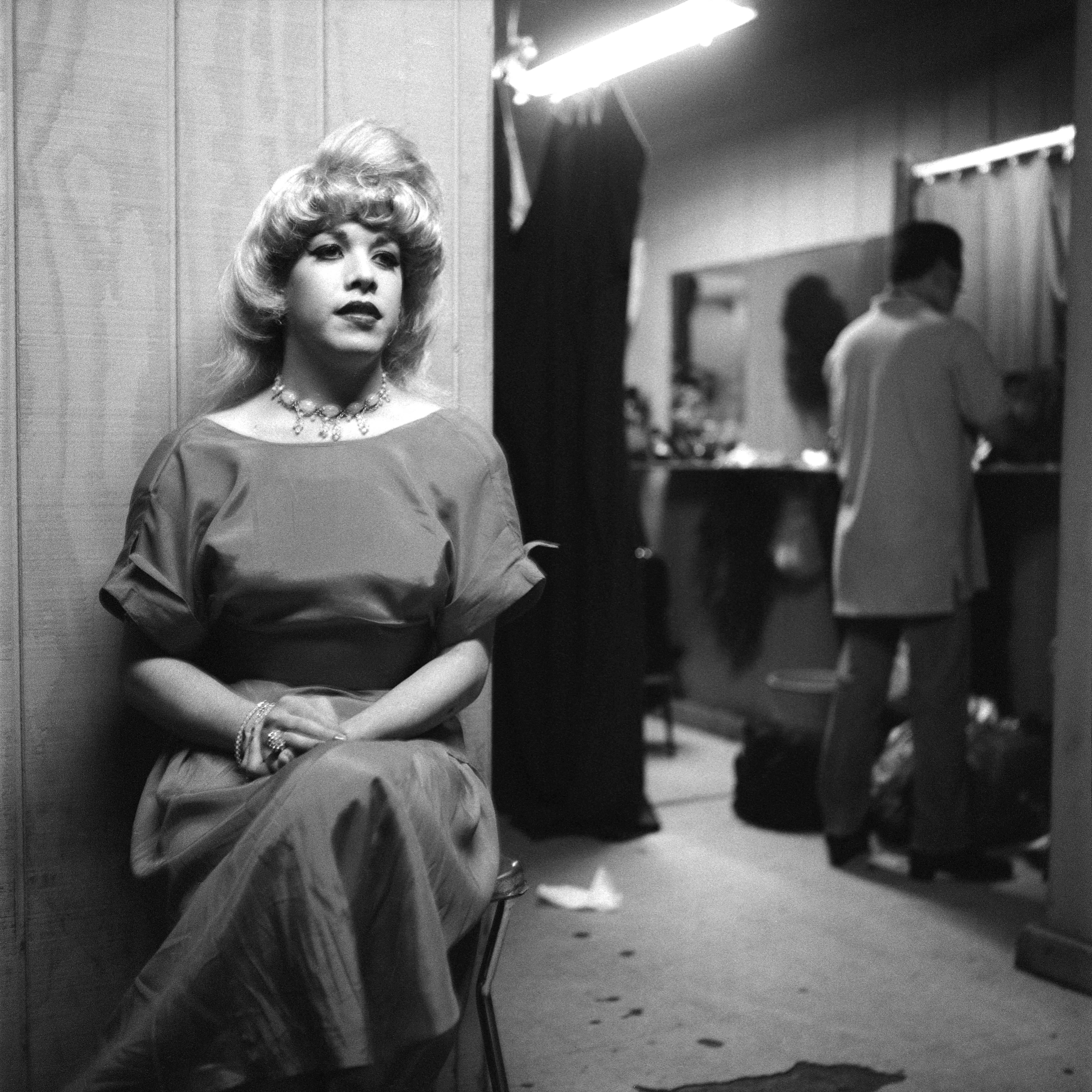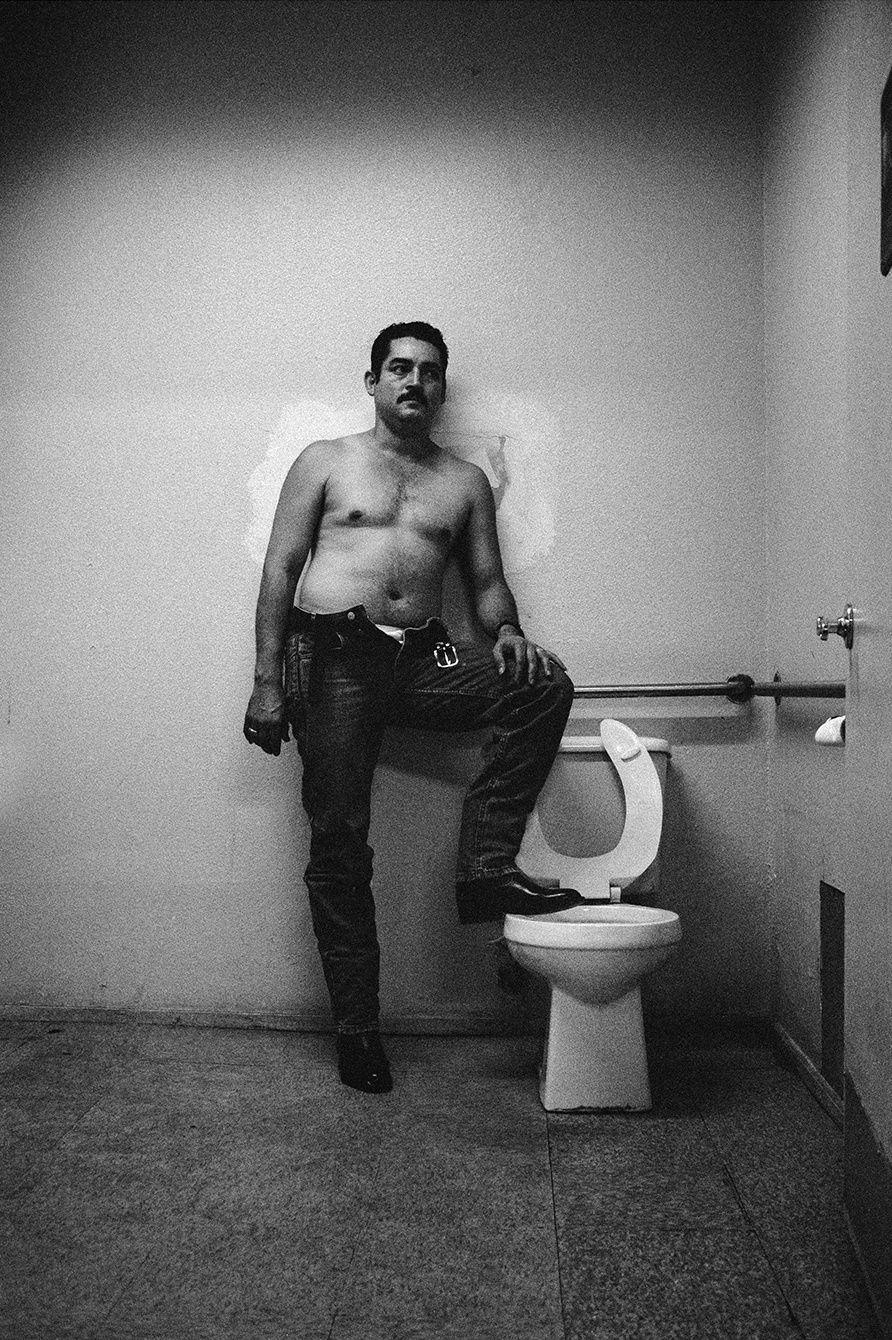People At Parties
by Gracie Hadland

Reynaldo Rivera, Party, Echo Park, 1995. Courtesy of the artist and Reena Spaulings Fine Art, NY/LA.
A certain generation of queer history in Los Angeles was revealed to me when I first met photographer Reynaldo Rivera shortly after moving to the city in 2018. Reynaldo Rivera: Provisional Notes for a Disappeared City, a book of his photographs of his contemporaries in East L.A. and Mexico—drag queens, musicians, artists, friends, lovers, siblings—was published by Semiotext(e) last year. A number of these photos, spanning the 80s and 90s, were featured in the 2021 Made in L.A. biennial at the Hammer Museum, and a solo exhibition of his work was also presented at Reena Spaulings in New York in October.
A devoted documentarian among his peers, Rivera often photographed queens and performers in various now extinct gay nightclubs around Los Angeles, like Mugy’s, La Plaza, or Silverlake Lounge. Rivera also shot punk and noise shows for L.A. Weekly (R.I.P.), where he first began working as a janitor. Flanked by a Cuban café and an AA meeting house, Silverlake Lounge, which opened in 1938, is one of the rare L.A. sites featured in Rivera’s work that is still in operation today, though it was recently bought by the owner of a chic organic wine bar and attracts a crowd of mostly white, aging indie rockers leftover from the early aughts. Right now a banner is plastered above the door: “Under New Management,” I guess to entice people who knew the place in its earlier iteration, its transition precisely a point of appeal. The city that was once Reynaldo’s and his friends’ stomping ground has since disappeared; even if certain sites are still standing the vibe has turned into something quite different—“artisan coffee places and new restaurants with uncomfortable seating,” according to Vaginal Davis. In an email to Rivera after a recent stay in Silver Lake she writes, “The only place that seemed the same was Café Tropical on Sunset Blvd…. The people I passed were either these well-off clueless young types or the very ragged and bedraggled, worn down by the harshness of what is now life in Los Angeles.”1

Reynaldo Rivera, Kids, San Diego de la Unión, Mexico, 1989. Courtesy of the artist and Semiotext(e).

Reynaldo Rivera, Crime Scene (step-grandfather), Mexico City, 1983. Courtesy of the artist and Reena Spaulings Fine Art, NY/LA.
Born in Mexicali in 1964, Reynaldo Rivera grew up in motion, traveling between itinerant homes in California and Mexico. Some of his earliest work includes photographs from his transient childhood in Stockton, where he picked cherries with his father; in the San Joaquin Valley, where he found work at the Campbell’s soup cannery; and in San Diego de la Unión, Mexico, where he and his sister were sent to live with their abusive grandmother. These images have a quality of Depression era reportage, as if they were taken in the 1930s rather than the early eighties. Two black and white photographs from 1983 show the aftermath of his step-grandfather’s murder in Mexico City. The bed is bloodied from stab wounds, the floor is dirt.
To supplement his income, Rivera’s father often sold stolen goods out of a pool hall in downtown L.A. It was how Reynaldo obtained his very first camera, discovered among his father’s loot. By the nineties, the photographer was settled in Echo Park, where he lived with his sisters among a community of primarily Latinx artists, punks, and queers who could live cheaply in the city’s pre-gentrified eastside. In his documentation of performers and queens, Rivera’s lens tends to veer off to the side of the stage, more drawn to what’s going on behind the curtain or in the bathroom or out on the sidewalk. It’s these liminal moments between sets, bodies preparing, primping, and disrobing, that he captures so well. In one shot from the mid-nineties, Rivera captures someone waiting in the wings to perform at Silverlake Lounge: she sits outside the doorway of the dressing room while another girl puts on their look. Her legs are crossed, hands in her lap, her face poised in anticipation of the imminent show.

Reynaldo Rivera, Performer, Silverlake Lounge, 1995. Courtesy of the artist and Reena Spaulings Fine Art, NY/LA.
Some of my favorites are just of people at parties. Party, Echo Park (1995) is of a crowded hallway, a disorganized line for the bathroom or for a drink. The focal point settles on a face on the other side of the crowd, a smile seen through an opening. The chatter can almost be heard, the swaying felt, blurry and warm. Other photos of Rivera’s step inside the party bathroom, perhaps the ultimate queer space for its opposition to the closet: a private world of drugs, vomit, kissing, piss, nudity, impulse, the site of mistakes, of reflection, of breaking down, or pulling oneself together. In Richard Villegas Jr., friend, and Enrique, Miracle Mile (1996), two men hold each other, pushed up against the wall while another is peeing. The camera’s gaze feels more participatory than voyeuristic because Reynaldo is not an interloper in the scene but a peer. He could easily be one of the subjects, as if he had just finished using the bathroom himself before snapping the shot. The clandestine nature of the spaces that Rivera photographs—bathrooms, dressing rooms—convey a powerful kind of intimacy without shame. We witness the vulnerability of a performer behind stage or without their costume, perhaps also suggesting the production and performance of gender. In another bathroom scene (Patron, Silverlake Lounge, 1983), a man stands with his pants unzipped, a power stance. He’s leaning with his leg up on the toilet seat, his belly hanging out and his shirt off, as if standing on the chest of an opponent after battle. Pre-piss? Post-felatio? His position is one of casual triumph in the gritty bathroom of Silverlake Lounge.

Reynaldo Rivera, Richard Villegas Jr., friend, and Enrique, Miracle Mile, 1996. Courtesy of the artist and Reena Spaulings Fine Art, NY/LA.
Reynaldo and I talked in his backyard in Lincoln Heights. Oil Can Harry’s, the 50-year-old gay club in Studio City famous for disco and line dancing, had just announced its closure that day. (The first time I went to Oil Can Harry’s, I made out with a stranger in the bathroom, a woman who I later learned designed t-shirts for Urban Outfitters. I never got her number.) Feeling defeated, I wanted Rey to tell me how good the parties used to be in L.A., and that a queer scene like that of his generation’s would never return, but he was reluctant to give in to my cynicism. He said, “I do actually believe they’re still out there… I imagine there’s always going to be young people like I was, kids that don’t go with the flow and that create their own communities. I don’t know about them because I’m not out there. Someone else needs to document.”2
Still, it’s hard to believe there’s space to go against the flow in the L.A. of today. As queer people are more readily accepted into the mainstream, and as our social lives exist more and more online, a party scene borne out of necessity, survival, ingenuity, and desire for community seems like a distant historical circumstance. In 2021 queer alt raves are ticketed and infrequent and tinged with nostalgia. The desire to connect with early generations of queer life in the city, to be part of a subculture, is apparent—there’s even a party called Subculture. This truth is met with ambivalence. I’m at once relieved to be distanced from the precarity that being gay once indicated, but I can’t help feeling that in some ways it afforded a kind of freedom, creatively and socially. In the introduction to Provisional Notes for a Disappeared City, Rivera tells Chris Kraus, “The earliest memories I had of feeling something was suffering, that feeling you have when someone leaves you.”3 It’s possible that photography for Rivera was at first a way to combat that loss, to quell the anxiety of death and disappearance that influenced his life from a young age. To romanticize queer culture of yore, like that documented in Rivera’s images, is to be confronted with the brutal reality from which it developed and existed. This is the paradox of being queer and coming-of-age in the city today: to understand the fallacy and delusion embedded in nostalgia for the past yet longing for the community that accompanied living on the edges.

Reynaldo Rivera, Gaby and Melissa, La Plaza, 1994. Courtesy of the artist and Reena Spaulings Fine Art, NY/LA.
The term nostalgia dates back to 1688, when a Swiss doctor defined it as a psychological malady, a manic longing for the past resulting in depression, obsession, and madness. Today this desire to retreat into the past is not totally surprising even if it means encountering contradiction. The frequency at which we are documenting and observing ourselves online creates a culture bogged down by its own nostalgia, like living constantly in a state of rewind. References upon references fold in on themselves, and any semblance of an underground scene is generated through so many filters that it becomes infected with irony, self-consciousness, and general apathy. “I think the folks that are creating all this content stuff right now are mostly just interested in themselves and how they personally look,” Rey proposes, “as opposed to everyone else around them. I was more interested in the other characters in my movie, the ones that made my plot more interesting. I mean, I was so uninterested in myself.”4 Save for a few self-portraits, Rey has consistently turned the camera outward to the community around him. His subjects seem to look at the camera as if they would look at a loved one—uninhibited, intimate, and direct. Perhaps this preoccupation with the self is what hinders forming and finding authenticity in a queer party scene, organically, as Rey and his peers did then. It’s not a scene if there’s only one person in it.
Much of contemporary social life is also generated by algorithms. Meeting someone seemingly random on Instagram, Tumblr, or Twitter was once exciting, but today feels increasingly banal, expected, and constraining. Our phones alert us with notifications like, “You have a new memory,” creating nonstop wistfulness and self-awareness through memes and selfies and memorializing a “scene” based on what the algorithm shapes for us, however disingenuously. It’s a culture of documentation, not culture being documented. The artist Moyra Davey writes in her book Index Cards, “This phenomenon of latency, while not exactly eliminated from digital work, has been diminished. A fundamental principle of the photographic process has been altered by the introduction of previsualization, by the little screens that allow us to compose, rearrange, jettison.”5 This previsualization happens socially as well as photographically. We “jettison” into a scene, preserving a version of ourselves for immediate reflection, no waiting period. Davey continues, “This ‘not knowing’ has, for the better part of two centuries, been an integral part of working with emulsions and celluloid… Not to be too mystical about it, but the delay, the waiting, and the anticipation were all part of a process that embraced accident and contingency.”6
The impulse to document seems like knowing something is happening, an understanding of time and its fragility, a desire to preserve a moment that you swear was there. When I ask Rey if this was something he thought about he says no, but he acknowledges his medium as evidence of this impulse: “I did take the photos. I always knew they were being preserved for me. I do remember one day in, like, ‘93 we were doing one of those group photos. Michael Queenland made some comments that were in that same state of mind. We had just taken photos outside of our apartment and he made a comment about how ‘this is going to be important,’ like he felt the importance of what that image was going to be in another 30 years or something. And I thought it was kind of funny, but it stuck in my mind. I mean, it’s hard not to feel that when you’re taking pictures.”7
It’s clear that Rivera has an affection for Los Angeles and its reputation as a place of self-invention. He writes in his essay published by Semiotext(e), “In a city that reinvents itself with every new generation, one has to leave breadcrumbs to be able to find the way back… You can look for that brownstone in New York, but here in Los Angeles you might just find a parking lot, but this also allows for creating a truly new city without all the baggage of the past… You come to Los Angeles to reinvent yourself.”8 If Los Angeles is a city that facilitates reinvention of the self, then its disappearance must be inevitable, or at the very least expected. L.A. is infamously the city without a history. It requires Angelenos to remember what’s been paved over. Chris Kraus writes of Rivera’s work, “The city becomes a place where all the histories moving underneath the skin of the present can become visible… Photos of breakdancers from the street feel suspended in time, suffused with a presence that seems to include things that aren’t physically there.”9
It seems to me that all of his images contain the past, present, and future beneath this “skin” of silver gelatin. I can’t help but feel a longing preserved in the work—a desire, perhaps, to combat ephemerality, erasure, and the deaths of people who died too young; a deliberate need to write a history of oneself knowing no one else will do it for you. In this way Rivera takes up a position within the legacy of queer photographers who worked on the fringes. I think of Alvin Baltrop, another documentarian, who photographed the gay cruising scene, quite literally on the edge of the city, at Chelsea Piers in New York in the 1970s.10 I also think of a statement published by the artists involved in the 1989 Artists Space exhibition Witnesses: Against Our Vanishing, about those in the New York art world affected by AIDS: “We must take responsibility for creating our future.”11 And as Rivera demonstrates, that future could not exist without documentation of the present.
Reynaldo writes in Provisional Notes for a Disappeared City, “This book is an attempt to leave a record that we were here, since we tend to get erased and leave our neighborhoods without any traces… We leave very little material behind. We’re always found in the footnotes of others.”12 I recently went for a drink at Silverlake Lounge, which is still divey, but more consciously so. More apparent than any gays were Silver Lake rocker dads wearing vintage leather jackets. A girl with bangs and a wide-brimmed hat sang country-pop to a thin crowd. Whiskey was cheap and old cable news played on one of the TVs behind the bar. While the website amusingly mythologizes Silverlake Lounge as a space for Latinx queers and drag, only vague traces of this history remain in the rainbow flag above the stage. Otherwise, there are only photos.

